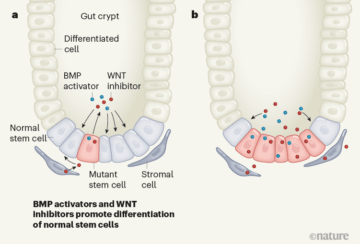Chia and DeGregori in Nature:
 Decades of research have revealed how mutations contribute to the evolution of malignant cells and to the ultimate characteristics of a given tumour. There is growing recognition that the surrounding tissue environment affects the natural selection of these mutation-driven characteristics. Less appreciated, however, have been the effects of interactions between malignant cells and their neighbouring wild-type cells — and how, through these interactions, malignant cells shape the surrounding environment to their advantage. Writing in Nature, Yum et al.1, Van Neerven et al.2 and Flanagan et al.3 provide crucial insights into the competitive dynamics of cancer cells and their neighbouring cells in the intestine.
Decades of research have revealed how mutations contribute to the evolution of malignant cells and to the ultimate characteristics of a given tumour. There is growing recognition that the surrounding tissue environment affects the natural selection of these mutation-driven characteristics. Less appreciated, however, have been the effects of interactions between malignant cells and their neighbouring wild-type cells — and how, through these interactions, malignant cells shape the surrounding environment to their advantage. Writing in Nature, Yum et al.1, Van Neerven et al.2 and Flanagan et al.3 provide crucial insights into the competitive dynamics of cancer cells and their neighbouring cells in the intestine.
To study interactions between cells with cancer-promoting mutations and neighbouring cells in their native environment, Yum et al.1 developed a microscopy-based approach that uses a multicolour system to monitor cellular lineages (clones) in mice. This enabled the authors to track intestinal stem cells that express cancer-associated mutations in two key genes, Kras and Pik3ca, and also to assess their wild-type neighbouring cells. The authors report that the presence of intestinal stem cells harbouring these mutated genes increased the rate of differentiation of the surrounding wild-type cells. This outcome was driven by the mutant stem cells secreting specific factors — molecules that activate the BMP signalling pathway, and others that inhibit the WNT signalling pathway (Fig. 1).
More here.
